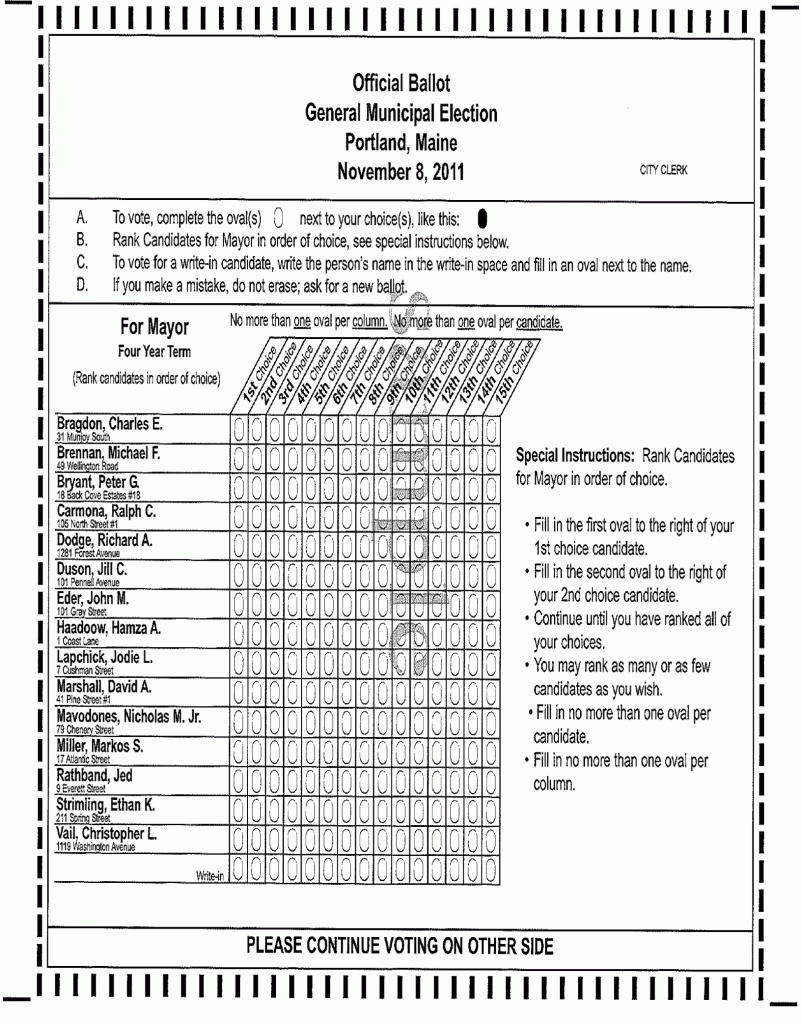In Some Elections, Second Best Might Be Good Enough
On Tuesday, Nov. 8, Portland, Maine will hold its first mayoral election in 88 years. (The mayorship previously rotated between city council members.) But it’s going to be unusual for another reason: voters will use a ranked choice system, which means they have to list the 15 candidates in order of preference. An image of the ballot appears below. Here’s the AP’s David Sharp reporting on the complexities:
The ballot is too complicated to be understood by the city’s voting machines, so only first-place votes will be announced on the night of the election, said Caleb Kleppner, vice president of TrueBallot Inc. The final outcome of the race won’t be known until the following day when the ballots are scanned and all of voters’ rankings are extrapolated, Kleppner said.

Portland voters won’t be the only ones making multiple commitments on election day. A handful of municipalities across the country use similar systems. San Francisco has been using ranked choice voting (RCV) since 2004, and voters in next week’s mayoral election there will be allowed to rank their top three candidates.

(Digital Vision)
In San Francisco, it works like this: if no single candidate gets more than 50 percent of first-choice votes, the lowest-ranking candidate will be eliminated from the pool. The ballots that listed the eliminated candidate as first choice will have their second-ranked choice tallied up instead. Since voters’ second choices are built-in, the city avoids having to hold a costly runoff.
Steven Hill, a political consultant and the architect of San Francisco and Oakland’s systems, estimates that San Francisco has already saved $7.2 million using RCV and will save another $3 million by avoiding a runoff this year. The city’s Department of Elections wouldn’t provide numbers to confirm, but they did note that the last city-wide runoff election, held in 2003, cost $3.5 million.
One of the strange things about these elections, though, is candidates don’t necessarily need the most first-choice votes to win the election.
Sound confusing? There has been plenty of griping about the complicated system, including criticism that the ballots alienate minorities. But Steven Hill sees evidence that the system has actually increased minority representation. For instance, the number of racial minorities on the Board of Supervisors has doubled from four to eight since the institution of RCV. Because minority communities don’t need to throw their weight behind a single candidate to avoid a split vote, Hill thinks they end up with more of a say.
Another possible consequence of RCV is less mudslinging. Because a vote for another candidate isn’t necessarily a vote against any other, politicians don’t need to engage in as much cutthroat smearing to sway voters away from other candidates. Hill says, “with ranked choice voting, incentives are different. The winner may need the second rankings from the supporters of some of his or her opponents. So that means you have to be more careful about what you say about those opponents.” So on election day, you can (theoretically) play nice.
In our latest Marketplace podcast, Stephen Dubner talks with Kai Ryssdal about how special interests have greater influence when turnout is low. Because turnout in runoff elections is typically low, RCV may even help curb special interests’ influence and increase voter participation in the eventual outcome.
Do any readers out there live in municipalities that use vote ranking? Have you seen it change the incentive structure for politicians or voters?

Comments